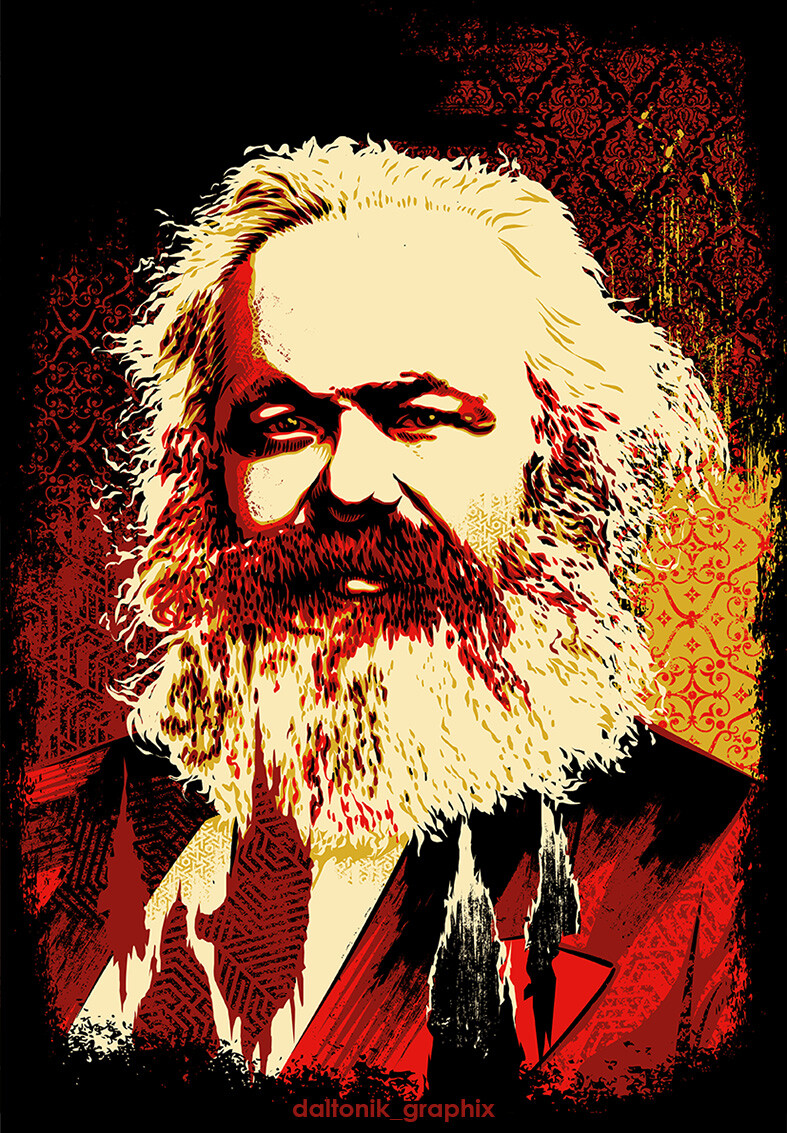I read Capital, and the whole thing just went over my head. I really couldn't understand what he was getting at. Could any comrades help explain the LTV? Thanks! ![]()
the value of a thing = the average amount of labour-time that goes into making that thing
That's it.
It's a little more complex than that, because there's a concept of utility value to be explored.
A week spent assembling a 100 HP engine creates less value than a week spent assembling a 200 HP engine.
The LTV posits that all value ultimately derives from human labor, but it does not equate all efforts as equally valuable.
The creation of fictious capital can consume labor and produce nothing of value, for instance. The issue at hand is acknowledging this labor as wasted value.
This gets you to the distinction between use value and exchange value. Two individuals engaged in equivalent labor can create items with exchange value that differs from their use value. This creates a market-driven incentive to chase the exchange value without consideration of the use value.
This can create an illusion of valueless labor, as something with high use value (say, parental child care) is equated with no exchange value simply because it can't efficiently be exchanged.
The conclusion of LTV is not simply that all labor has value. It is that labor expanded in pursuit of exchange value at the expense of use value is a form of waste.
A week spent assembling a 100 HP engine creates less value than a week spent assembling a 200 HP engine.
This sentence is a denial of the LTV
It is not.
Again, labor value can be wasted. An idle laborer, for instance, has potential value that is not being actualized. A laborer given busy work (the Keynesian "digging holes to justify a salary" approach to full employment) has potential value that is not being actualized.
The laborer still has value to contribute to the economy, regardless of what actions that person is performing. But whether those actions generate the maximal use value depends on how that laborer is engaged. Anything under the maximal use value is effectively wasted labor.
No, a 100 HP and 200 HP engine have different components that each have different amounts of value embedded in them. They are different products. In the market, the 200 HP engine is priced higher than the 100 HP engine not because it produces more HP, but because it is larger, has more materials in it, and the components have to deal with larger heat and energy loads so they may even be higher quality.
The 200 HP engine might even have twice as much material and components in it. There is more labor going into mining and producing those components, and also more work going into the assembly.
No, a 100 HP and 200 HP engine have different components that each have different amounts of value embedded in them.
True. But that doesn't mean the 100 HP engine is cheaper to make. It could just as easily be cruder and less efficient. An engine that is assembled incorrectly, for instance, can have less (or no) output relative to one assembled optimally. An engine made from improper components can have a lower safe operating tolerance. Or it may simply be thanks to advances in material sciences / engine geometry / assembly technique that we achieve more torque from an equivalent input of labor and raw inputs.
You can build a 65" flat screen TV today using less material and fewer expensive components than a 16" tube-screen TV from the 1980s. That's entirely thanks to our understanding of the physics and material science surrounding the assembly process.
In either case, the concept of labor value doesn't change. The laborer has access to a certain capital/material stock and attempts to create a useful output. The relative success of the endeavor can create more utilitarian value based on a host of factors. Recognizing inefficient labor application as waste means prioritizing a certain amount of labor education, capital improvement, and R&D in order to conserve labor value.
By contrast, in a market-based economy, all we care about is the exchange value of the components we produce. If a 100 HP motor sells for the same as a 200 HP motor, then there's no incentive to upscale and no conception of waste at the level of the manufacturer. In some cases, there may be incentives to discourage conversion to 200 HP motors, because this would require increased input costs for the producer that don't resolve as exchange-value revenues.
The labor value of the market-based economy may be equivalent to that of the planned-economy, assuming the number of man-hours is the same.
But the waste of labor value in the market-based economy is going to be higher, because the economy continues to produce lower-utility 100 HP engines in pursuit of maximum exchange value return. The real expected utility value of those labor hours is lower.
A Marxist sees this disparity in utility as an economic cost (labor value is being wasted), while a Capitalist only recognizes the marginal return on sales and therefore considers 100 HP motors and 200 HP motors as equivalent (labor value is ignored).
Would it be sufficient to say that labor that is employed to produce commodities at the social average of costs, quality, the utility of the final product, etc. is what gives commodities their value? That would account for ineffective utilization of labor as you state.
labor that is employed to produce commodities at the social average of costs, quality, the utility of the final product, etc. is what gives commodities their value?
That commodities/services are a consequence of labor applied to capital over time.
And the labor value actualized/squandered is equal to the utility of the commodities/services they produced as a percentage of the maximal utility value they could have produced.
Labor value exists as a function of potential man hours * time * most-efficient-product/service rendered. And that labor value can be realized or lost, depending on whether the laborer is employed efficiently. Thus, the goal of a well-run economy is to maximize the utility output of individuals in order to achieve a long-term improvement in quality of life for the polity.
Hence "from each according to their skill, to each according to their need". Maximize utility of labor inputs. Equitably distribute outputs.
I do feel like you're glossing over the labor that goes into sourcing and processing all of the "advanced" components that goes into more modern (and perhaps lighter) products. This affects the cost of those components as they have massive ounts of labor going into them. The impression I'm getting is you're looking purely at the final stage of assembling the product, which is not the only place that labor imbues value into a thing.
I agree that it is only the exchange value that determines its price. But the labor value is reflected in the cost of production all the way up the line. However, the price is tethered near to the cost of production as a floor in order to make a profit.
I do feel like you're glossing over the labor that goes into sourcing and processing all of the "advanced" components that goes into more modern (and perhaps lighter) products.
I'm trying to keep it reasonably simple by confining the discussion to a single individual performing a single job with relatively uniform components. I'll happily concede that modern components can carry their own costs. But I might counter that those costs are potentially lower than their historical peers.
Consider the Chinese molten salt nuclear engine, which uses thorium fuel rather than uranium or plutonium. Or consider an engineer dedicated to building a wind turbine instead of a coal stack. Consider how much paper we've conserved by taking our bureaucracy digital. Or the wattage requirements we've reduced by going from candles, to bulbs, to LEDs. Advancing technology doesn't automatically mean creating more physical waste. In many cases, advances can substantially conserve energy.
But that's getting away from LTV and into ecological economy.
But the labor value is reflected in the cost of production all the way up the line.
A laborer who produces less utility than their peer is not less valuable as a laborer. Said laborer is simply wasting the difference in utility output. In a planned economy, administrators can recognize this waste and transition the laborer into the more efficient role, because they are fixated on utility.
the price is tethered near to the cost of production as a floor in order to make a profit.
Price can radically deviate from cost. We've seen that for years, in mark-ups between foreign wholesalers and domestic post-industrial retailers. H&M, famously, generates full multiples of the exchange value on an article of clothing it buys overseas and sells in the US. This creates a strong incentive to produce and market large volumes of textiles in an economy that is already oversaturated with them.
The labor required to make these surplus garments is functionally wasted. The disparity in pay is largely a consequence of coercion. And the labor of these workers is therefore squandered to generate items of near-zero use value but enormous exchange value.
This is not an instance in which textile worker labor is valueless, but one in which their value is deliberately extracted, exported, and destroyed in pursuit of maximized exchange value.
The distinction is that potential labor value exists in every laborer, while utility value produced by that labor can vary based on how much of the labor is successfully applied versus how much is squandered.
Again, I can point you to a laborer who is entirely unemployed. This individual still has the same potential labor value they had when they were working. This labor value is simply being wasted in unemployment.
I'm trying to keep it reasonably simple by confining the discussion to a single individual performing a single job with relatively uniform components. I'll happily concede that modern components can carry their own costs. But I might counter that those costs are potentially lower than their historical peers.
This point does make sense - of course modern components carry costs. My issue is that you don't seem to include the value imbued on these commodities by their labor during their production. The cost of an assembling an engine is not just the assemblers time. It's all of the materials that go into it as well. You are also suggesting in your example that the labor time of assembling a smaller engine is the same as assembling a larger engine. I doubt that's true too.
I assume you wanted an example that shows "wasted labor" but I'm not sure why, either.
Consider the Chinese molten salt nuclear engine, which uses thorium fuel rather than uranium or plutonium. Or consider an engineer dedicated to building a wind turbine instead of a coal stack. Consider how much paper we've conserved by taking our bureaucracy digital. Or the wattage requirements we've reduced by going from candles, to bulbs, to LEDs. Advancing technology doesn't automatically mean creating more physical waste. In many cases, advances can substantially conserve energy.
What are you talking about? Nothing about modern technology is less costly than older technology. Have you felt the weight of an LED bulb? Those things have so many components, metals, semiconductors, plastics, heavy metals, etc in them. They create so much more physical water and require labor inputs from so many individual people to make. Also, I doubt that "conserving paper" by going digital is a net savings. Paper is a renewable resource, and digital storage consumes more energy than a lot of countries do. I know that's not your point, really, but I think it's worth pointing out. What does conserving energy have to do with labor value anyway
My issue is that you don't seem to include the value imbued on these commodities by their labor during their production.
You can play this game at any stage of the production cycle. Rather than describing the transformation of individual components into a finished motor, you could describe uncast steel transformed into individual components or iron and tin blasted into steel or undeveloped real estate transformed into iron and tin mines.
I assume you wanted an example that shows "wasted labor" but I'm not sure why, either.
To distinguish between the idea of labor mispriced and misapplied.
Nothing about modern technology is less costly than older technology
The number of lumen you receive per watt of power applied to an LED is significantly more than the lumen you receive per watt of power applied to a wax candle. LEDs are far cheaper to produce than candles, they last longer than candles, and they produce far less waste. Everything about an LED is less costly than a candle.
Those things have so many components, metals, semiconductors, plastics, heavy metals, etc in them.
I've got an LED bulb on the end of my phone that produces light equivalent to an old car headlight. It weighs less than an ounce, contains no heavy metals, and will last the full life of the phone. To produce the same amount of light over the same time period with a candle, I would need buckets of wax and miles of wick. And the sourcing of those materials would create mountains of trash. Nevermind the ecological impact of all that burning and melting of materials.
Also, I doubt that "conserving paper" by going digital is a net savings
In a country with 50M additional people, the consumption of paper products between 2000 and 2020 has fallen by over 30%. We are expecting to see another 10-15% reduction in the next decade, which amounts to 10M tonnes of paper per year. This, in a country that consumes 17% of global paper.
Paper is a renewable resource
The process of paper production has an enormous ecological footprint, both in terms of the raw destruction of tree life and the chemicals and energy waste that goes into the manufacturing process.
What does conserving energy have to do with labor value anyway
Activities with a lower energy footprint produce less physical waste and reduce future demands on labor to perform cleanup and mitigation of the damage that this waste causes.
Sorry my guy ignoring the ridiculous environmental destruction of LED light production, which includes semiconductors, metals, plastics, and control electronics, doesn't mean they're less costly. In fact, they take a huge number of additional people, pieces of equipment, energy, etc than an Edison bulb. Same with paper. Saying that reducing paper use saves paper is a tautology, and doesn't compare with the massive environmental cost of data centres and cloud computing.
Look, we've gotten off topic from LTV. My issue is around the background costs of production and how that relates to the profitability of products. I think your examples don't encompass some of the important parts of LTV, because they are focused for some reason on energy savings, and don't take resource extraction into account.
Marx was working with the idea of LTV, but it preceded him. It was the idea that labor is what transforms the inputs to the outputs, creating increased value in the process of production. If you follow this logic for all production, you end up with the conclusion that all of trade is just exchanging labor-modified things and services, and even just labor at its fundamental level.
Capital is Marx's critique of political economy. It takes this idea but uses his own formulation embedded in his own definitions of the commodity and value, taking great pains to be clear that he's not taking a simplistic view that, say, the value of a bicycle is not simply how much accumulated labor it took to build it. People who are bad at building bikes would produce a more expensive bike, but that doesn't change the value of bikes in general. That depends on aggregates and averages, including how much labor it takes to build a bike on average, how many bikes are needed/wanted, etc etc.
Importantly, Marx frames value as a calculation deriving from a supply-side viewpoint. It is the owner class who are obsessed with value and, in particular, how they might use it to maximize their profits in order to survive competition. To do so, they (1) own the means of production and (2) oversee the workers. They are monitoring and adapting the value creation process (workers turning inputs into outputs with expected higher commodity market sale prices) to decrease the cost of inputs, including labor, and they understand it to simultaneously be an expenditure that can be decreased by simply paying workers less money while also knowing their whole operation is dependent on their work.
This leads us to Marx's theory of exploitation, eventually, but at this point he's more or less done with LTV. He used it to point out labor's part in creating value, that it does literally everything to transform inputs into higher-value outputs, and did so specifically to point out how this functions under the capitalist system where labor is not in control of production.
"Worker take time and energy to make thing but not own thing, Boss take thing away and sell thing expensive, Boss not work but make more money from sell, Worker make less money from sell."
—Carl Marmaduk
You have no idea how true that is actually. It means a lot.
Thanks!
Take a producer of goods, it pays for constant capital (something it doesn't have cost-control over, electricity, machines, ip rights, rent etc) and variable capital (worker compensation). To produce a profit he has to underpay workers for the amount of stuff they produced (e.g. worker owned factory producing 100 tonnes of pasta, paying 20 tonnes of pasta for inputs, would be able to afford exactly 80 tonnes of pasta).
Taking the whole spheres of production capitalists end up with excess (profits/exploitation) basket of goods (money equivalent of 10 tonnes of pasta here, bag of coffee beans there), which they utilize to finance their consumption, means of production development, and paying for unproductive sector jobs (finance, defense etc)
That sounds more like an explanation of 'surplus value' than of the question above.
Yeah, this is like condensed capital v.1-3, but comrade said they've struggled to internalize it. Labor theory of value by itself doesn't have explanatory power, just saying stuff embeds labor, its value and price are vaguely connected into this embedded labor. But also here are 1000 pages how this gets distorted by equalization of profit rates across spheres of production, means of production, competition, finance capital and other factors.
Under the labor theory of value, when you eat a burrito and poop, you are creating value.
Edit: Wait, I'm sorry, were we being serious or silly?
this video is a pretty good and intuitive explanation: https://youtu.be/xzqm9QHls60
In a very simplistic explanation, it costs money to keep workers alive and working. That means that it costs "money" to create a product that requires work. That imbues the product with some value, the abstract cost of producing it.
But that value is not necessarily the price. If a product is very scarse and desired, it might sell for way more than was required to create it, generating profit for the seller (be it an artisan or a capitalist). It is generally assumed that this profit will generate competition, which tends to reduce the price back to something closer to its value.
On the other hand, if something is too underconsumed that it's market price is lower than the cost of producing it, the corporation will either go bankrupt, stop producing that product or lower wages (or fire people) in order to recover some profit.
In either case, the price of commodities can fluctuate around their labour value, but it serves as a baseline for that price from which there can't be too much consistent deviation.
That means that the value of any commodity is dictated in part by the cost of maintaining and operating capital (which I haven't described here), and in part by the absolute minimum necessary to keep the workers alive and working.
I found a YouTube link in your comment. Here are links to the same video on alternative frontends that protect your privacy:
The capitalist buys the labor power (power is effort applied over time) from the worker for a block of time to produce commodities. The worker contributes some labor power to each commodity so that the value of the commodity is partially made up of that particular worker's labor. The commodity is made of raw materials and other parts that were made or picked or mined by workers, and the machines that are used were also made by workers, and a little value of the machine transfers to the commodity too. So everything that comprises the exchange value of the commodity, is made up of worker labor power.
The capitalist doesn't want to sell the commodity at a loss, so the faster the worker produces commodities for the capitalist, the more money the capitalist makes. Its also always better for the capitalist to get more work out of a fewer number of workers. The capitalist doesn't want to break even either, so the capitalist has the worker produce more commodities than what it costs to buy the workers labor power for that period of time. So for some of the work day, the worker is making commodities that will pay for their own sustenance wages, but for the rest of the day the worker is making commodities for the capitalist, basically the worker is working for free for a large part of the day.
The value created by selling these commodities made with free labor is reinvested in more capital that makes more money for the capitalist. This is why everything that the capitalist owns, all of their capital that they use to make profits, is paid for with the labor power of the workers.
https://anticapital0.wordpress.com/calculating-surplus-value-to-facilitate-workplace-organizing/
Others have already provided answers, but I strongly believe that anyone who wants to study Vol 1 will benefit so much more if you start with some primer of classical economics/political economy that covers Adam Smith and David Ricardo.
Marx’s Capital Vol 1 is simply the continuation of those works and he assumed most of his readers at the time were already familiar with Smith and Ricardo. Marx transcended those previous works by bringing class analysis and dialectical materialism into the mix and bringing the Smith and Ricardo’s theories of capitalism to its logical conclusion, but he doesn’t exactly hold your hand on topics he assumed you should already know!
Reading Marx's Wage Labor and Capital is a great prep for those first few difficult chapters of Capital
Just a little plug for the c/theory reading group, you might be able to find some helpful pointers there. We've talked about this quite a bit in the last couple weeks.










